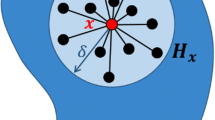Abstract
Formulations for diffusion processes based on graph Laplacian kernels have been recently used to solve linear transient heat transfer problems with insulated boundary conditions by way of a spectral-based semi-analytical approach. This has been called the “spectral graph” (SG) approach. In this paper, we show that the meshfree discretization for corresponding peridynamic (PD) models leads to a graph structure that allows us to introduce the “graph Laplacian PD” (GL-PD) method using the semi-analytical approach employed in the SG approach to solve the transient heat diffusion problems. The new method, GL-PD, can be seen as a “hybrid” between SG and PD with meshfree discretization. We discuss the similarities and differences between the GL-PD and the SG approaches. Main differences are related to calibration and discretization procedures. We use a 1D heat diffusion example to highlight some limitations the spectral-based semi-analytical method in the SG approach has compared with the direct time-integration normally used in computing solutions to transient diffusion problems. We then propose an extension of the semi-analytical approach to solve transient diffusion problems with Dirichlet boundary conditions, using a recent scaling and squaring algorithm that calculates the matrix exponential of non-symmetric matrices.











Similar content being viewed by others
References
Ghosh S, Das N, Gonçalves T, Quaresma P, Kundu M (2018) The journey of graph kernels through two decades. Comput Sci Rev 27:88–111. https://doi.org/10.1016/j.cosrev.2017.11.002
Gasteiger J, Thomas Engel E (2003) Chemoinformatics: A Textbook. https://doi.org/10.1002/3527601643.fmatter
Xenarios I, Salwínski L, Duan XJ, Higney P, Kim S-M, Eisenberg D (2002) DIP, the Database of Interacting Proteins: a research tool for studying cellular networks of protein interactions. Nucleic Acids Res 30(1):303–305. https://doi.org/10.1093/nar/30.1.303
Wasserman S, Faust K (1994) Social network analysis: Methods and applications. Cambridge University Press. https://doi.org/10.1017/CBO9780511815478
Harchaoui Z, Bach F (2007) Image classification with segmentation graph kernels. IEEE Conference on Computer Vision and Pattern Recognition, Minneapolis, MN, USA, 2007:1–8. https://doi.org/10.1109/CVPR.2007.383049
Weis M, Naumann F (2006) Detecting Duplicates in Complex XML Data. 22nd International Conference on Data Engineering (ICDE’06), 109. https://doi.org/10.1109/ICDE.2006.49
Das N, Ghosh S, Gonçalves T, Quaresma P (2014) Using Graphs and Semantic Information to Improve Text Classifiers, pp: 324–336, in: Przepiórkowski A., Ogrodniczuk M. (eds) Advances in Natural Language Processing. NLP 2014. Lecture Notes in Computer Science, vol 8686. Springer, Cham. https://doi.org/10.1007/978-3-319-10888-9_33
Debnath AK, Lopez de Compadre RL, Debnath G, Shusterman AJ, Hansch C (1991) Structure-activity relationship of mutagenic aromatic and heteroaromatic nitro compounds. Correlation with molecular orbital energies and hydrophobicity. J Med Chem 34(2):786–797. https://doi.org/10.1021/jm00106a046
Kondor RI, Lafferty JD (2002) Diffusion kernels on graphs and other discrete input spaces. Proceedings of the Nineteenth International Conference on Machine Learning: 315–322.
Lafferty J, Lebanon G (2005) Diffusion kernels on statistical manifolds. J Mach Learn Res 6:129–163. https://doi.org/10.1184/r1/6604859.v1
Kloster K, Gleich DF (2014) Heat kernel based community detection, in Proceedings of the ACM SIGKDD International Conference on Knowledge Discovery and Data Mining 1386–1395. https://doi.org/10.1145/2623330.2623706
Reza Yavari M, Cole KD, Rao P (2019) Thermal modeling in metal additive manufacturing using graph theory. J Manuf Sci Eng 141(7):071007. https://doi.org/10.1115/1.4043648
Cole KD, Yavari MR, Rao PK (2020) Computational heat transfer with spectral graph theory: quantitative verification. Int J Therm Sci 153:106383. https://doi.org/10.1016/j.ijthermalsci.2020.106383
Silling SA (2000) Reformulation of elasticity theory for discontinuities and long-range forces. J Mech Phys Solids 48(1):175–209. https://doi.org/10.1016/S0022-5096(99)00029-0
Bobaru F, Zhang G (2015) Why do cracks branch? A peridynamic investigation of dynamic brittle fracture. Int J Fract 196(1–2):59–98. https://doi.org/10.1007/s10704-015-0056-8
Mehrmashhadi J, Wang L, Bobaru F (2019) Uncovering the dynamic fracture behavior of PMMA with peridynamics: The importance of softening at the crack tip. Eng Fract Mech 219:106617. https://doi.org/10.1016/j.engfracmech.2019.106617
Huang D, Lu G, Qiao P (2015) An improved peridynamic approach for quasi-static elastic deformation and brittle fracture analysis. Int J Mech Sci 94:111–122. https://doi.org/10.1016/j.ijmecsci.2015.02.018
Lipton R (2014) Dynamic brittle fracture as a small horizon limit of peridynamics. J Elast 117(1):21–50. https://doi.org/10.1007/s10659-013-9463-0
Karpenko O, Oterkus S, Oterkus E (2020) Influence of different types of small-size defects on propagation of macro-cracks in brittle materials. Journal of Peridynamics and Nonlocal Modeling 2(3):289–316. https://doi.org/10.1007/s42102-020-00032-z
Liu PF, Li XK (2019) Dynamic void growth and localization behaviors of glassy polymer using nonlocal explicit finite element analysis. Journal of Peridynamics and Nonlocal Modeling 1(1):3–13. https://doi.org/10.1007/s42102-018-0003-y
Behzadinasab M, Foster JT (2019) The third Sandia Fracture Challenge: peridynamic blind prediction of ductile fracture characterization in additively manufactured metal. Int J Fract 218(1):97–109. https://doi.org/10.1007/s10704-019-00363-z
Yolum U, Taştan A, Güler MA (2016) A peridynamic model for ductile fracture of moderately thick plates. Procedia Structural Integrity 2:3713–3720. https://doi.org/10.1016/j.prostr.2016.06.461
Amani J, Oterkus E, Areias P, Zi G, Nguyen-Thoi T, Rabczuk T (2016) A non-ordinary state-based peridynamics formulation for thermoplastic fracture. Int J Impact Eng 87:83–94. https://doi.org/10.1016/j.ijimpeng.2015.06.019
Hu W, Ha YD, Bobaru F (2011) Modeling dynamic fracture and damage in a fiber-reinforced composite lamina with peridynamics. Int J Multiscale Comput Eng 9(6):707–726. https://doi.org/10.1615/IntJMultCompEng.2011002651
Hu W, Ha YD, Bobaru F (2012) Peridynamic model for dynamic fracture in unidirectional fiber-reinforced composites. Comput Methods Appl Mech Eng 217:247–261. https://doi.org/10.1016/j.cma.2012.01.016
Gao Y, Oterkus S (2019) Fully coupled thermomechanical analysis of laminated composites by using ordinary state based peridynamic theory. Compos Struct 207:397–424. https://doi.org/10.1016/j.compstruct.2018.09.034
Hu YL, Madenci E (2017) Peridynamics for fatigue life and residual strength prediction of composite laminates. Compos Struct 160:169–184. https://doi.org/10.1016/j.compstruct.2016.10.010
Bobaru F, Duangpanya M (2010) The peridynamic formulation for transient heat conduction. Int J Heat Mass Transf 53(19–20):4047–4059. https://doi.org/10.1016/j.ijheatmasstransfer.2010.05.024
Bobaru F, Duangpanya M (2012) A peridynamic formulation for transient heat conduction in bodies with evolving discontinuities. J Comput Phys 231(7):2764–2785. https://doi.org/10.1016/j.jcp.2011.12.017
Oterkus S, Madenci E, Agwai A (2014) Peridynamic thermal diffusion. J Comput Phys 265: 71-96. https://doi.org/10.1016/j.jcp.2014.01.027
Wang L, Xu J, Wang J (2018) A peridynamic framework and simulation of non-Fourier and nonlocal heat conduction. Int J Heat Mass Transf 118:1284–1292. https://doi.org/10.1016/j.ijheatmasstransfer.2017.11.074
Diyaroglu C, Oterkus S, Oterkus E, Madenci E (2017) Peridynamic modeling of diffusion by using finite-element analysis. IEEE Transactions on Components, Packaging and Manufacturing Technology 7(11):1823–1831. https://doi.org/10.1109/TCPMT.2017.2737522
Jafarzadeh S, Chen Z, Li S, Bobaru F (2019) A peridynamic mechano-chemical damage model for stress-assisted corrosion. Electrochim Acta 323:134795. https://doi.org/10.1016/j.electacta.2019.134795
De Meo D, Oterkus E (2017) Finite element implementation of a peridynamic pitting corrosion damage model. Ocean Eng 135:76–83. https://doi.org/10.1016/j.oceaneng.2017.03.002
Chen Z, Bobaru F (2015) Peridynamic modeling of pitting corrosion damage. J Mech Phys Solids 78:352–381. https://doi.org/10.1016/j.jmps.2015.02.015
Jafarzadeh S, Chen Z, Zhao J, Bobaru F (2019) Pitting, lacy covers, and pit merger in stainless steel: 3D peridynamic models. Corros Sci 150:17–31. https://doi.org/10.1016/j.corsci.2019.01.006
Bobaru F, Yang M, Alves LF, Silling SA, Askari E, Xu J (2009) Convergence, adaptive refinement, and scaling in 1D peridynamics. Int J Numer Meth Eng 77(6):852–877. https://doi.org/10.1002/nme.2439
Silling SA, Askari E (2005) A meshfree method based on the peridynamic model of solid mechanics. Comput Struct 83(17–18):1526–1535. https://doi.org/10.1016/j.compstruc.2004.11.026
Deo N (2017) Graph theory with applications to engineering and computer science. Courier Dover Publications.
Bıyıkoglu T, Leydold J, Stadler PF (2007) Laplacian eigenvectors of graphs. Lecture notes in mathematics, 1915.
Merris R (1994) Laplacian matrices of graphs: a survey. Linear Algebra Appl 197:143–176.
Carslaw HS, Jaeger JC (1992) Conduction of heat in solids. Clarendon press.
Boyce WE, DiPrima RC, Meade DB (2017) Elementary differential equations. John Wiley & Sons
Greub WH (2012) Linear algebra. Springer Science & Business Media.
Hammond DK, Gur Y, Johnson CR (2013) Graph diffusion distance: a difference measure for weighted graphs based on the graph Laplacian exponential kernel. IEEE Global Conference on Signal and Information Processing 2013:419–422. https://doi.org/10.1109/GlobalSIP.2013.6736904
Fouss F, Francoisse K, Yen L, Pirotte A, Saerens M (2012) An experimental investigation of kernels on graphs for collaborative recommendation and semisupervised classification. Neural Netw 31:53–72. https://doi.org/10.1016/j.neunet.2012.03.001
Chen Z, Niazi S, Bobaru F (2019) A peridynamic model for brittle damage and fracture in porous materials. Int J Rock Mech Min Sci 122:104059. https://doi.org/10.1016/j.ijrmms.2019.104059
Jafarzadeh S, Chen Z, Bobaru F (2018) Peridynamic modeling of intergranular corrosion damage. J Electrochem Soc 165(7):C362. https://doi.org/10.1149/2.0821807jes
Zhao J, Chen Z, Mehrmashhadi J, Bobaru F (2018) Construction of a peridynamic model for transient advection-diffusion problems. Int J Heat Mass Transf 126:1253–1266. https://doi.org/10.1016/j.ijheatmasstransfer.2018.06.075
Chen Z, Bobaru F (2015) Selecting the kernel in a peridynamic formulation: a study for transient heat diffusion. Comput Phys Commun 197:51–60. https://doi.org/10.1016/j.cpc.2015.08.006
Prakash N (2019) Calibrating bond-based peridynamic parameters using a novel least squares approach. Journal of Peridynamics and Nonlocal Modeling 1(1):45–55. https://doi.org/10.1007/s42102-018-0002-z
Chen Z, Ju JW, Su G, Huang X, Li S, Zhai L (2019) Influence of micro-modulus functions on peridynamics simulation of crack propagation and branching in brittle materials. Eng Fract Mech 216:106498. https://doi.org/10.1016/j.engfracmech.2019.106498
Chen X, Gunzburger M (2011) Continuous and discontinuous finite element methods for a peridynamics model of mechanics. Comput Methods Appl Mech Eng 200(9–12):1237–1250. https://doi.org/10.1016/j.cma.2010.10.014
Du Q, Tian L, Zhao X (2013) A convergent adaptive finite element algorithm for nonlocal diffusion and peridynamic models. SIAM J Numer Anal 51(2):1211–1234. https://doi.org/10.1137/120871638
Jafarzadeh S, Larios A, Bobaru F (2020) Efficient solutions for nonlocal diffusion problems via boundary-adapted spectral methods. J Peridyn Nonlocal Model 2, 85–110. https://doi.org/10.1007/s42102-019-00026-6
JafarzadehWang L, Larios A, Bobaru FS (2021) A fast convolution-based method for peridynamic transient diffusion in arbitrary domains. Comput Methods Appl Mech Engrg 375:113633. https://doi.org/10.1016/j.cma.2020.113633
Murakami S (2012) Continuum damage mechanics: a continuum mechanics approach to the analysis of damage and fracture. Springer Science & Business Media.
Silling SA, Epton M, Weckner O, Xu J, Askari E (2007) Peridynamic states and constitutive modeling. J Elast 88(2):151–184. https://doi.org/10.1007/s10659-007-9125-1
Wu P, Zhao J, Chen Z, Bobaru F (2020) Validation of a stochastically homogenized peridynamic model for quasi-static fracture in concrete. Eng Fract Mech 237:107293. https://doi.org/10.1016/j.engfracmech.2020.107293
Bobaru F, Ha YD, Hu W (2012) Damage progression from impact in layered glass modeled with peridynamics. Central Eur J Eng 2(4):551–561. https://doi.org/10.2478/s13531-012-0020-6
Le QV, Bobaru F (2018) Surface corrections for peridynamic models in elasticity and fracture. Comput Mech. 61: 499–518. https://doi.org/10.1007/s00466-017-1469-1
Bobaru F, Ha YD (2011) Adaptive refinement and multiscale modeling in 2D peridynamics. Int J Multiscale Comput Eng 9(6):635–659. https://doi.org/10.1615/IntJMultCompEng.2011002793
Gu X, Zhang Q, Xia X (2017) Voronoi-based peridynamics and cracking analysis with adaptive refinement. Int J Numer Meth Eng 112(13):2087–2109. https://doi.org/10.1002/nme.5596
Henke SF, Shanbhag S (2014) Mesh sensitivity in peridynamic simulations. Comput Phys Commun 185(1):181–193. https://doi.org/10.1016/j.cpc.2013.09.010
Huilai L, Zhuoqun W, Jingxue Y, Junning Z (2001) Nonlinear diffusion equations. World Scientific
Csanady GT (2012) Turbulent diffusion in the environment. Springer Science & Business Media.
Chen Z, Jafarzadeh S, Zhao J, Bobaru F (2021) A coupled mechano-chemical peridynamic model for pit-to-crack transition in stress-corrosion cracking. J Mech Phys Solids 146:104203. https://doi.org/10.1016/j.jmps.2020.104203
MATLAB (2020) Natick. The MathWorks Inc, Massachusetts
Higham NJ (2005) The scaling and squaring method for the matrix exponential revisited. SIAM J Matrix Anal Appl 26(4):1179–1193. https://doi.org/10.1137/04061101X
Al-Mohy AH, Higham NJ (2010) A new scaling and squaring algorithm for the matrix exponential. SIAM J Matrix Anal Appl 31(3):970–989. https://doi.org/10.1137/09074721X
Greenberg MD (1988) Advanced Engineering Mathematics. Prentice-Hall
Funding
This work was supported by the National Science Foundation under CDS&E CMMI award No. 1953346.
Author information
Authors and Affiliations
Corresponding author
Rights and permissions
About this article
Cite this article
Wang, L., Bobaru, F. Connections Between the Meshfree Peridynamics Discretization and Graph Laplacian for Transient Diffusion Problems. J Peridyn Nonlocal Model 3, 307–326 (2021). https://doi.org/10.1007/s42102-021-00053-2
Received:
Accepted:
Published:
Issue Date:
DOI: https://doi.org/10.1007/s42102-021-00053-2




